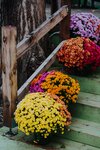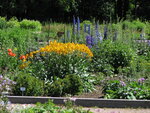 Narrowsburg
NarrowsburgLight Rain Fog/Mist, 43°
Wind: 8.1 mph
 Narrowsburg
Narrowsburg

As much as we want to ignore it, the colder temperatures are upon us. If you’ve taken advantage of summer gardening over the past few months, you’ll be harvesting what you’ve grown; but your gardening chores don’t stop there. There are a slew of ways to prepare your garden for a long winter’s sleep.
Perennials are popular for their ability to pop back up every spring or summer. But after the blooms have ended, you’re left with straggly, brown stems and bowing seedheads.
You might be tempted to shear everything down to the ground—but please don’t! Feel free to harvest the seeds (leaving some for the wildlife, to be kind), but try to leave those hollow stems and leaf litter alone to provide a home for overwintering pollinators.
Just as humans appreciate a blanket when the temperatures plummet, your yard appreciates getting tucked in, too. Spread some finished compost, topped with mulch, around your flower and vegetable beds to allow nutrients to be absorbed throughout the winter. Be mindful to mulch the bases of berry-producing plants, to avoid having a hard frost uprooting them.
Trees and shrubs tend to look overgrown by summer’s end, but refrain from pruning them if possible. According to the Old Farmer’s Almanac, pruning opens a wound that the plant won’t have time to heal before the frost strikes. And since pruning often encourages growth, any newly germinated branches will be too tender to survive the winter.
Those pots of autumnal chrysanthemums that you’ve styled on your front porch with bales of straw? When their flowers fade, give them a long drink, then break up those bales and thickly cover the pots before storing the plants in a sheltered spot. With luck, the mums will bounce back next year.
Evaluate any hanging or potted flowers you have, and consider overwintering them as houseplants inside your home. Geraniums, for example, are beautiful and bloom throughout the winter in a sunny window. An important caveat, however: Shake them well or spray with neem oil to keep many-legged hitchhikers from moving in, too.
Empty your outdoor containers and store them upside down in a garage or covered porch to avoid cracking. You can spread the used potting soil in outdoor beds—or store it for reuse next year. If you decide to reuse it (storing it through the winter in a garbage bag), “solarize” it to kill diseases by putting it in a black garbage bag and letting it sit in the sun for four to six weeks.
Reused potting soil also needs to be amended with slow-release fertilizers or compost before you use it in the spring.
Social media reminders are badgering us to let fallen leaves stay on the lawn to provide homes for overwintering critters, but there’s a happy medium somewhere between your lawn looking like a pig sty and looking like a shorn sheep. Don’t leave piles of leaves in soaked layers on the lawn; rake them up and put them in a pile out of the way. Unhoused pollinators will find them.
Conversely, mulch the leaves with your lawn mower and spread the mulch in your beds, or add it to the compost bin.
The same goes for that final fall mowing—don’t slice the grass within a half-inch of its life, but cut it short enough to withstand the weight of snow.
Fuel tanks on mowers, weed trimmers and other summer power equipment should be drained before the items are stored away for the winter.
Consider scrubbing your tools and wiping them down with a neutral oil to stave off rust.
Hot tip: Peppermint oil, set out in reed diffuser jars, is a great way to keep rodents out of your garage and shed.
Once your garden is tucked in, expect some melancholy at the end of all your hard work. But don’t fret; soon enough, your mailbox will overflow with seed catalogs. And in our local 5 and 6a planting zones, you can start some veggie seeds indoors just four months from now.
Comments
No comments on this item Please log in to comment by clicking here